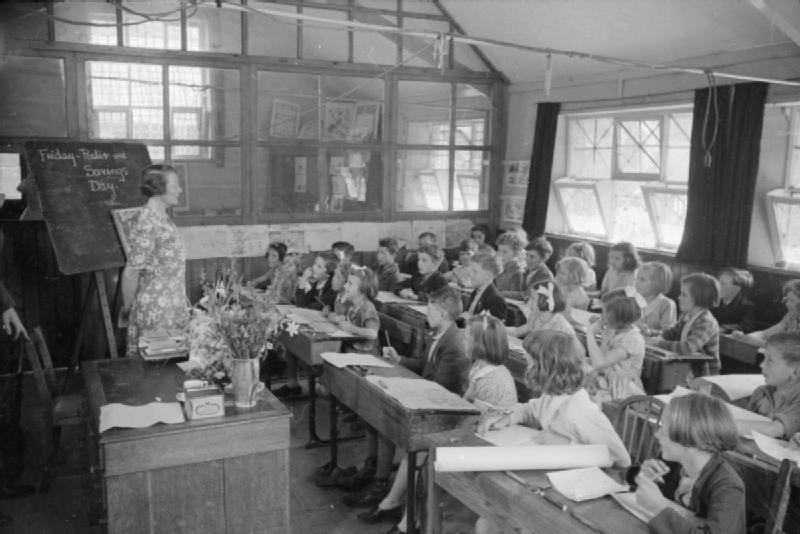It’s time for schools to upgrade both technology and pedagogy
by Larry Magid
This post first appeared in the San Jose Mercury News

Teaching methods, in some schools, haven’t changed much since this picture was taken (Creative Commons License)
As students return to school, it’s time to think about absolute necessities like pens, paper, school clothes, a laptop or tablet and, of course, a learning network that enables them to interact with fellow students and teachers.
OK, that network may not yet be mandatory. But an increasing number of teachers are flocking toward “connected learning,” which involves changing not only educational methods, but also some fundamental assumptions about the nature of education.
Connected learning
An infographic at ConnectedLearning.tv offers up a definition that refers to connected learning as a model that holds out the possibility of “reimagining the experience of education in the information age.” It goes on to suggest that the power of technology be used to “fuse young people’s interests, friendships and academic achievements” through hands-on production, shared purpose and open networks.
That’s a refreshingly forward thinking definition of the term. For many educators, “connected learning,” simply means using the power of the Internet to make it more efficient to bring resources into the classroom. It reminds me of a presentation I saw a few years ago at an International Society for Technology in Education (ISTE) conference, in which a smart board vendor demonstrated her product by modeling a teacher-dominated geography lesson, using the smart board in almost the same way teachers have long used chalk boards to display information in a top-down fashion. It struck me at the time that much of today’s so-called “technology in education” is nothing more than using 21st century technology to enhance 19th century pedagogy.
And that brings me back to “reimagining” education by finding ways to disrupt the processes and power relationships that have so long defined students as both the consumers and products of the educational system rather than co-creators and collaborators.
Student networking
Not all companies are thinking of ways to reinforce old learning models. 1StudentBody (www.1sb.com), a Palo Alto startup run by serial entrepreneur Mandeep Dhillon, is leveraging the power of networking to help students help themselves and their peers.
Dhillon views “peer-to-peer connections” as a powerful way to connect students within and among schools to collaborate in the learning process. His just released app, NoteSnap (initially available only for iPhone and iPad, with an Android version coming), enables students to use their smartphone to take notes in class and, by default, share them with other students. The app lets students use the phone’s camera, for example, to take a picture of the classroom’s whiteboard to share the content with others in the class. The app automatically cleans up the image to improve readability and immediately shares it with others. It also allows students to ask questions, and there is the option of asking anonymously if you “don’t want people to think you’re clueless.”
I asked Dhillon why students would want to use the app. After all, schools are often competitive, and sharing with other students helps them, but not you. His answer was aspirational. The product is not simply designed to appeal to the lowest common denominator of getting a better grade, but reflects his philosophy that learning and work will be increasingly collaborative.
It makes sense to me. In the real world, you’re rewarded not for what you know, but how you’re able to leverage your knowledge, skills and talents for the benefit of others. Not only are companies increasingly encouraging workers to share their knowledge among colleagues, but there is also a growing open-source movement that encourages competitors to share some aspects of their intellectual property for the benefit of the entire industry and the world at large. In the real world, success is not a zero-sum game where your success depends on other people’s lack of success.
I grew up at the tail end of the industrial age and got to live through the information age which, said, Dhillon, is about over now that information has become a commodity. “We’re now in the networked age,” he said, where what you know is far less important than your ability to use networks to obtain whatever it is you need and share it with others.
Other apps and services
There are, of course, other apps aimed at students and educators, including Edmodo, a network of 37 million teachers, students and parents designed to help teachers manage coursework and encourage all users to collaborate. Another app, ShowMe interactive whiteboard lets you use an iPad to create “whiteboard-style tutorials.”
Evernote isn’t specifically for students, but it does allow users to take notes, snap pictures, save and share Web links and organize and share bits of information.
And, for the more animated students and teachers out there, there is GoAnimate for Schools that lets users create amazing animated videos by dragging and dropping and adding audio dialogue, complete with lip-syncing. One of my favorite features is an animated whiteboard that lets you type in text for your character to write on the board.

